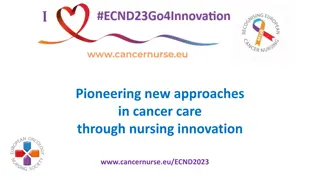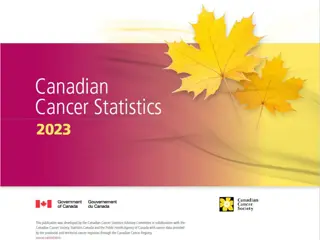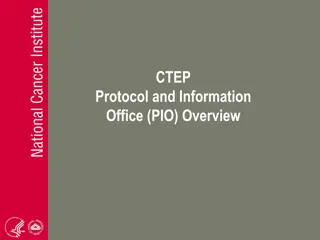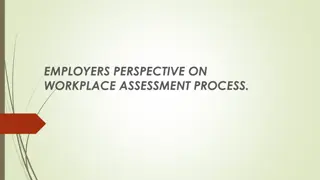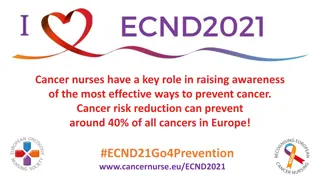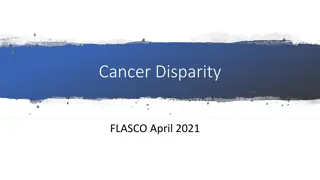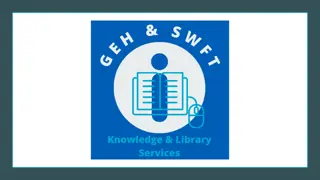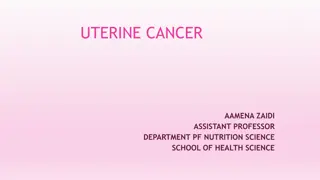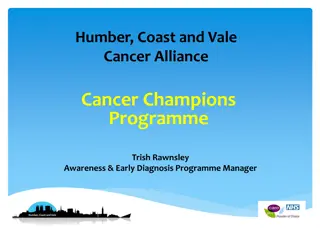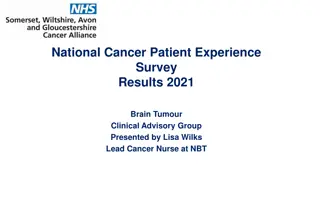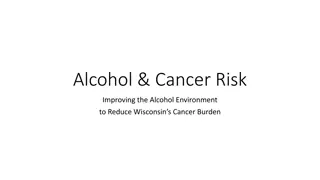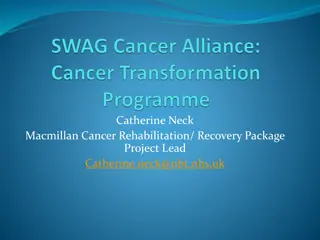Lower GI Cancer Highlights from ASCO GI 2023
Prof. Andrea Sartore-Bianchi and Prof. Shubham Pant presented key findings at the GI CONNECT meeting summarizing advancements in lower gastrointestinal (GI) cancer treatments. Clinical takeaways included updates on FTD/TPI plus bevacizumab for refractory CRC patients, postoperative cfDNA/ctDNA kinetics, and a study on balstilimab plus botensilimab in MSS mCRC patients. NRG-GI002 data on veliparib and pembrolizumab in unselected patients was also discussed. These insights aim to enhance treatment strategies and outcomes in lower GI cancer patients.
Download Presentation

Please find below an Image/Link to download the presentation.
The content on the website is provided AS IS for your information and personal use only. It may not be sold, licensed, or shared on other websites without obtaining consent from the author.If you encounter any issues during the download, it is possible that the publisher has removed the file from their server.
You are allowed to download the files provided on this website for personal or commercial use, subject to the condition that they are used lawfully. All files are the property of their respective owners.
The content on the website is provided AS IS for your information and personal use only. It may not be sold, licensed, or shared on other websites without obtaining consent from the author.
E N D
Presentation Transcript
GI CONNECT MEETING SUMMARY LOWER GI CANCER HIGHLIGHTS FROM ASCO GI 2023 Prof. Andrea Sartore-Bianchi, MD Niguarda Cancer Center, Milano, Italy Prof. Shubham Pant, MD University of Texas, MD Anderson Cancer Center, Houston, USA JANUARY 2023 2
DEVELOPED BY GI CONNECT A picture containing graphical user interface This programme is developed by GI CONNECT, an international group of experts in the field of gastrointestinal oncology. Acknowledgement and disclosures This GI CONNECT programme is supported through an independent educational grant from Bayer. The programme is therefore independent, the content is not influenced by the supporter and is under the sole responsibility of the experts. Please note: The views expressed within this programme are the personal opinions of the experts. They do not necessarily represent the views of the experts institutions, or the rest of the GI CONNECT group. Expert Disclaimers: Prof. Andrea Sartore-Bianchi has received financial support/sponsorship for research support, consultation, or speaker fees from the following companies: Amgen, Bayer, Sanofi and Servier Pharmaceuticals Prof. Shubham Pant has received financial support/sponsorship for research support, consultation, or speaker fees from the following companies: Xencor, 4D, Tyme 3
THIS PROGRAMME HAS BEEN DEVELOPED BY THE FOLLOWING EXPERTS Prof. Andrea Sartore-Bianchi Niguarda Cancer Center, Italy Prof. Shubham Pant MD Anderson Cancer Center, USA 4
CLINICAL TAKEAWAYS SUNLIGHT trial1 FTD/TPI plus bevacizumab improved OS and PFS in refractory CRC patients and should be considered a standard of care in the refractory treatment setting Kinetics of postoperative cfDNA/ctDNA2 Post operative ctDNA-positivity is significantly associated with shorter recurrence-free survival Clinical data are insufficient at this stage to consider MRD testing as standard of care for patients with resectable CRC Study of balstilimab plus botensilimab in MSS mCRC patients3 Durable objective responses were observed in heavily pre-treated MSS CRC patients treated with balstilimab plus botensilimab. Further investigation is warranted NRG-GI0024 Neither veliparib or pembrolizumab significantly improved short-term outcomes in unselected patients when added to TNT NRG-GI002 provides TNT outcome data for benchmarking in future LARC trials CRC, colorectal cancer; cfDNA, cell-free DNA; ctDNA, circulating tumour DNA; FTD/TPI, trifluridine/tipiracil; LARC, locally advanced rectal cancer; MRD, molecular residual disease; MSS, microsatellite stable; OS, overall survival; PFS, progression free survival; TNT, total neoadjuvant therapy 1. Tabernero J, et al. J Clin Oncol 41, 2023 (suppl 4; abstr 4); 2. Cohen SA, et al. J Clin Oncol 41, 2023 (suppl 4; abstr 5); 3. El-Khoueiry AB, et al. J Clin Oncol 41, 2023 (suppl 4; abstr LBA8); 4. George TJ, et al. J Clin Oncol 41, 2023 (suppl 4; abstr 7) 5
TRIFLURIDINE/TIPIRACIL PLUS BEVACIZUMAB FOR THIRD-LINE TREATMENT OF REFRACTORY METASTATIC COLORECTAL CANCER: THE PHASE 3 RANDOMISED SUNLIGHT STUDY Tabernero J, et al. J Clin Oncol 41, 2023 (suppl 4; abstr 4) 6
SUNLIGHT: BACKGROUND AND STUDY DESIGN Standard treatment options for refractory mCRC (3rd/4thline) include trifluridine/tipiracil and regorafenib based on data from the RECOURSE and CORRECT trials1,2 Recent data from the FRESCO-2 study suggests that fruquintinib may also be a future treatment option for these patients3 FTD/TPI plus bevacizumab improved OS and PFS in a previous randomised phase 2 trial in heavily pre-treated mCRC patients4 SUNLIGHT was designed to further confirm the efficacy and safety of the combination treatment5 Trifluridine/tipiracil p.o. 35 mg/m2BID day 1-5 and 8-12; every 28 days Patients with mCRC Histologically confirmed mCRC After two prior regimens Disease progression or intolerance Known RAS status ECOG PS 0-1 Primary endpoint: OS in full analysis set Secondary endpoints: PFS DCR ORR Safety profile QoL Bevacizumab 5 mg/kg IV day 1 and 15; every 28 days Follow-up every 8 weeks for radiologic progression and/or survival status R 1:1 Trifluridine/tipiracil p.o. 35 mg/m2BID day 1-5 and 8-12; every 28 days BID, twice a day; DCR, disease control rate; ECOG PS, Eastern Cooperative Oncology Group performance status; FTD/TPI, trifluridine/tipiracil; IV, intravenous; mCRC, metastatic colorectal cancer; ORR, objective response rate; OS, overall survival; PFS, progression-free survival; p.o., by mouth; QoL, quality of life; R, randomisation; RAS, RAS proto-oncogene GTPase 1. Mayer RJ, et al. N Engl J Med. 2015;372:1909-19; 2. Grothey A, et al. Lancet. 2013;381:303-12; 3. Dasari NA, et al. Ann Oncol. 2022; 33 (suppl_7): S808-S869 (ESMO 2022 presentation); 4. Van Custem E, et al. Ann Oncol 2020; 31 (9): 1160-1168; 5. Tabernero J, et al. J Clin Oncol 41, 2023 (suppl 4; abstr 4) (ASCO GI 2023, oral presentation) 7
SUNLIGHT: EFFICACY RESULTS (FULL ANALYSIS SET) FTD/TPI plus bevacizumab improved OS and PFS in refractory CRC patients PROGRESSION-FREE SURVIVAL OVERALL SURVIVAL (PRIMARY ENDPOINT) FTD/TPI plus bevacizumab (N=246) FTD/TPI FTD/TPI plus bevacizumab (N=246) FTD/TPI (N=246) (N=246) Median OS, months 10.8 7.5 Median PFS, months 5.6 2.4 100 100 6-month OS rate, % 77 61 6-month PFS rate, % 43 16 Survival probability (%) Survival probability (%) 12-month OS rate, % 43 30 12-month PFS rate, % 16 1 80 80 FTD/TPI plus bevacizumab group FTD/TPI group 60 60 HR, 0.44 (95% CI, 0.36-0.54) p<0.001 40 40 FTD/TPI plus bevacizumab group FTD/TPI group 20 20 HR, 0.61 (95% CI, 0.49-0.77) p<0.001 0 0 0 1 2 3 4 5 6 7 8 9 10 11 Months 12 13 14 15 16 17 18 19 20 0 1 2 3 4 5 6 7 8 9 10 11 12 13 14 15 16 17 18 Months No. at risk FTD/TPI plus bevacizumab group FTD/TPI group No. at risk FTD/TPI plus bevacizumab group FTD/TPI group 246 246 244 242 239 230 230 205 217 184 203 163 183 143 160 120 149 108 131 95 119 85 104 76 88 63 69 44 52 24 37 16 24 10 13 5 2 2 0 1 0 0 246 246 242 236 198 147 179 109 153 74 128 56 99 36 89 29 70 19 61 12 52 8 43 6 25 2 18 2 13 1 7 1 4 0 2 0 0 0 CI, confidence interval; CRC, colorectal cancer; FTD/TPI, trifluridine/tipiracil; HR, hazard ratio; OS, overall survival; PFS, progression free survival Tabernero J, et al. J Clin Oncol 41, 2023 (suppl 4; abstr 4) (ASCO GI 2023, oral presentation) 8
SUNLIGHT: SAFETY RESULTS OVERALL SAFETY TEAEs IN 20% OF ALL PATIENTS FTD/TPI plus bevacizumab (N=246) FTD/TPI FTD/TPI plus bevacizumab (N=246) FTD/TPI (N=246) Event (any cause), n (%) (N=246) TEAE, n (%) Any grade Grade 3 or 4 Any grade Grade 3 or 4 Overall AEs 241 (98) 241 (98) Neutropenia 153 (62) 106 (43) 126 (51) 79 (32) FTD/TPI-related AEs 221 (90) 200 (81) Nausea 91 (37) 4 (2) 67 (27) 4 (2) Bevacizumab-related AEs 119 (48) NA Anemia 71 (29) 15 (6) 78 (32) 27 (11) 178 (72) 171 (70) Severe (grade 3) AEs Asthenia 60 (24) 10 (4) 55 (22) 10 (4) Serious AEs 61 (25) 77 (31) Fatigue 53 (22) 3 (1) 40 (16) 9 (4) Treatment-related deaths 0 0 Diarrhea 51 (21) 2 (1) 46 (19) 6 (2) AEs leading to withdrawal from the study 31 (13) 31 (13) Decreased appetite 50 (20) 2 (1) 38 (15) 3 (1) FTD/TPI plus bevacizumab (N=246) FTD/TPI Dose modification, n (%) (N=246) Dose reductions 40 (16) 30 (12) Dose delays 171 (70) 131 (53) Hypertension (10% vs 2%), nausea and neutropenia occurred more frequently in the combination group One case of febrile neutropenia with FTD/TPI plus bevacizumab versus six with FTD/TPI AE, adverse event; FTD/TPI, trifluridine/tipiracil; TEAE, treatment emergent AE Tabernero J, et al. J Clin Oncol 41, 2023 (suppl 4; abstr 4) (ASCO GI 2023, oral presentation) 9
SUNLIGHT: SUMMARY FTD/TPI plus bevacizumab improved OS and PFS in refractory CRC patients Improvements in survival occurred in all clinically relevant subgroups The safety profile was manageable and consistent with the individual safety profiles of FTD/TPI and bevacizumab Clinical Takeaway SUNLIGHT results indicate that FTD/TPI plus bevacizumab should be considered a standard of care in the refractory treatment setting There was a modest increase in toxicities and financial cost, but this comes with significant improvements in mPFS and mOS CRC, colorectal cancer; FTD/TPI, trifluridine/tipiracil; (m)OS, median overall survival; (m)PFS, median progression-free survival Tabernero J, et al. J Clin Oncol 41, 2023 (suppl 4; abstr 4) (ASCO GI 2023, oral presentation); Deming D, Discussant of abstract 4 (ASCO GI 2023) 10
KINETICS OF POSTOPERATIVE CIRCULATING CELL-FREE DNA AND IMPACT ON MRD DETECTION RATES IN PATIENTS WITH RESECTED STAGE I-III CRC Cohen SA, et al. J Clin Oncol 41, 2023 (suppl 4; abstr 5) CRC, colorectal cancer; MRD, minimal residual detection 11
BACKGROUND AND STUDY DESIGN BACKGROUND Circulating tumour DNA (ctDNA) has emerged as a useful biomarker for detecting molecular residual disease (MRD) in colorectal cancer (CRC)1,2 High levels of cell-free DNA (cfDNA) from normal tissue may limit the detection of tumour-derived ctDNA in certain clinical scenarios (immediately after surgery or during adjuvant therapy)3 The optimal timing of blood collection for reliable MRD detection after surgery or adjuvant therapy needs to be determined STUDY DESIGN A retrospective, US-based, multi-institutional study where data from commercial ctDNA testing in 16,347 patients with stage I-III CRC were analysed Complete clinical data were available for 417 patients with 2,538 plasma samples collected between 6/2019 and 4/2022 Median follow-up for relapsed and non-relapsed patients was 730 and 615 days, respectively A NGS assay (Signatera) was used to quantify ctDNA prior to surgery and postoperatively The kinetics of total cfDNA was analysed and compared with the ctDNA MRD positivity rates at various time points after surgery NGS, next generation sequencing; US, United States 1. Kotani D, et al. Nature Med. 2023;29:127-34; 2. Malla M, et al. J Clin Oncol. 2022;40:2846-57; 3. Henriksen TV, et al. Mol Oncol. 2020;14:1670-9; 4. Cohen SA, et al. J Clin Oncol 41, 2023 (suppl 4; abstr 5) (ASCO GI 2023, oral presentation) 12
RESULTS RECURRENCE-FREE SURVIVAL BY ctDNA STATUS cfDNA (A) CONCENTRATION AND ctDNA POSITIVITY (B) OVER TIME POST- SURGERY Full Cohort. Each dot = 5-day window MRD window (2-8 weeks), N=154 A 1.00 cfDNA concentration 15 Recurrence-free survival 0.75 10 HR = 14.1 (95% CI: 5.8-34.0) p<0.0001 5 0.50 0 0 100 200 300 B 60% 0.25 ctDNA positivity Recurrence during follow-up: ctDNA-ve: 5.8% (7/120) ctDNA+ve: 52.9% (18/34) 40% 0.00 20% 0 250 500 750 1000 Days from surgery 108 18 0% No. at risk ctDNA- ctDNA+ 120 34 62 5 20 2 0 0 0 100 200 300 cfDNA, cell-free DNA, CI, confidence interval; ctDNA, circulating tumour DNA; HR, hazard ratio; MRD, molecular residual disease Cohen SA, et al. J Clin Oncol 41, 2023 (suppl 4; abstr 5) (ASCO GI 2023, oral presentation) 13
SUMMARY cfDNA concentration is significantly increased in first 2 weeks post surgery Higher cfDNA levels did not impact ctDNA detection High ctDNA positivity in the first week after surgery Standard MRD testing windows could start as early as 2 weeks after surgery (Day 15+) Testing for MRD between weeks 2-4 showed similar sensitivity as weeks 4-8 Post operative ctDNA-positivity is significantly associated with shorter recurrence-free survival cfDNA, cell-free DNA; CRC, colorectal cancer; ctDNA, circulating tumour DNA; MRD, minimal residual disease Cohen SA, et al. J Clin Oncol 41, 2023 (suppl 4; abstr 5) (ASCO GI 2023, oral presentation) 14
SUMMARY CLINICAL TAKEAWAY Levels of cfDNA in plasma do not significantly affect ctDNA detection Standard testing window for MRD could start as early as 15 days postoperatively MRD testing via ctDNA is not standard of care for CRC The study provides the first stage III data and builds on the DYNAMIC trial results which demonstrated that a ctDNA-guided approach to the treatment of stage II colon cancer reduced adjuvant chemotherapy use without compromising recurrence-free survival At this stage, ctDNA is an interesting biomarker but further studies required before it can be used to guide treatment decisions cfDNA, cell-free DNA; CRC, colorectal cancer; ctDNA, circulating tumour DNA; MRD, minimal residual disease Cohen SA, et al. J Clin Oncol 41, 2023 (suppl 4; abstr 5) (ASCO GI 2023, oral presentation); Deming D. Discussant of abstract 5 (ASCO GI 2023); Tie J, et al. N Engl J Med 2022; 386: 2261-2272 15
RESULTS FROM A PHASE 1A/1B STUDY OF BOT, A NOVEL INNATE/ADAPTIVE IMMUNE ACTIVATOR, PLUS BAL (ANTI-PD-1 ANTIBODY) IN METASTATIC HEAVILY PRE- TREATED MSS CRC El-Khoueiry AB, et al. J Clin Oncol 41, 2023 (suppl 4; abstr LBA8) BAL, balstilimab; BOT, botensilimab; CRC, colorectal cancer; MSS, microsatellite stable; PD-1; programmed cell death protein 1 16
BACKGROUND AND STUDY DESIGN Botensilimab is an Fc-enhanced CTLA-4 inhibitor which is active in cold and IO refractory tumours1,2 Balstilimab is a PD-1 inhibitor with safety and efficacy analogous to approved anti-PD-1 mAbs3,4 Results are presented for an expanded phase 1a/1b study of BOT plus BAL in MSS CRC patients5 Key eligibility for CRC: Refractory metastatic CRC MSS by local assessment Prior IO allowed Tbili 1.5 IULN AST/ALT 2.5 IULN + BOT BAL Fc-enhanced CTLA-4 1 or 2 mg/kg Q6W PD-1 3 mg/kg Q2W Combination therapy Evaluable population: Treated with 1 or 2 mg/kg bot + bal as of 29 August 2022 with 1 Q6W imaging assessment 0 2 4 6 8 10 12 NCT03860272 Week ALT, alanine aminotransferase; AST, aspartate aminotransferase; BAL, balstilimab; BOT, botensilimab; CRC, colorectal cancer; CTLA-4, cytotoxic T-lymphocyte-associated protein 4; IO, immuno-oncology; IULN, institutional upper limit of normal; mAbs, monoclonal antibodies; MSS, microsatellite stable; PD-1; programmed cell death protein 1; Q X W, every X weeks; Tbili, bilirubin test 1. El-Khoueiry AB. SITC 2021 Annual meeting. Poster #479; 2. Wilky B, SITC 2022 Annual Meeting. Oral #778; 3. O Malley et al. Gynecol. Oncol. 2021;163:274-80; 4. O Malley et al. J Clin Oncol 2022;40(7):762-71; 5. El-KhoueiryAB, et al. J Clin Oncol 41, 2023 (suppl 4; abstr LBA8) (ASCO GI 2023, oral presentation) 17
RESULTS BASELINE DATA Median age: 57 years (25 83), 57% female Median prior lines of therapy: 4 31% had received prior immunotherapy ANY GRADE TRAEs IN 15% OF ALL PATIENTS EFFICACY Efficacy ORR, % (95% CI) BOR, n (%) CR PR SD DCR (CR + PR + SD), % (95% CI) Median OS, months (95% CI) Median PFS, months (95% CI) Median F/U, months (min, max) N (%) All Grade 3 28 (40) Grade 4 2 (3) N (%) All Grade 3 Grade 4 N=70 23 (14-34) Grade 64 (91) Grade Any TRAE Gastrointestinal IM diarrhea/colitisa Nausea Constitutional Fatigue Decreased appetite Chills Pyrexia Skin Rash Pruritus Endocrine Hypo/hyperthyroidism 19 (27) 12 (17) 0 0 0 0 1 (1) 15 (21) 37 (53) 76 (64-85) NR (10.3-NR) 4.1 (2.8-5.5) 7 (2, 31) 30 (43) 16 (23) 14 (20) 1 (1) 1 (1) 0 11 (16) 0 0 24 (34) 19 (27) 15 (21) 16 (23) 3 (4) 0 0 3 (4) 0 0 0 0 aimmune-mediated diarrhoea/colitis defined as patients who received steroids or infliximab BOR, best overall response; CI, confidence interval; CR, complete response; DCR, disease control rate; F/U, follow-up; NR, not reached; ORR, objective response rate; PFS, progression free survival; PR, partial response; SD, stable disease; TRAE, treatment-related adverse event El-KhoueiryAB, et al. J Clin Oncol 41, 2023 (suppl 4; abstr LBA8) (ASCO GI 2023, oral presentation) 18
RESULTS OVERALL SURVIVAL Efficacy evaluable population, N=70 Overall No active liver mets Active liver mets 1.0 0.9 NR (10.3-NR) NR (NR-NR) 9.4 (6.1-NR) Median, OS (95% CI) 63 (46-76) 81 (66-90) 40 (17-62) 12-month, OS (95% CI) Survival probability (%) 0.6 0.6 0.6 0.5 0.4 0.3 0.2 0.3 No active liver mets All patients Active liver mets 0.0 0 3 6 9 12 15 18 21 24 27 30 33 Months CI, confidence interval; NR, not reached; OS, overall survival El-KhoueiryAB, et al. J Clin Oncol 41, 2023 (suppl 4; abstr LBA8) (ASCO GI 2023, oral presentation) 19
SUMMARY Durable objective responses were observed in heavily pre-treated MSS CRC patients treated with BOT plus BAL The combination treatment was well tolerated with no new immune-mediated safety signals All objective responses and a better overall survival were observed to patients w/o active liver metastases A global phase 2 trial is ongoing investigating BOT as monotherapy and in combination with BAL or standard of care in patients with MSS CRC (NCT05608044) Clinical Takeaway Interesting early data for the first human trial of botensilimab plus balstilimab in patients with advanced MSS CRC. Further investigation is warranted. BAL, balstilimab; BOT, botensilimab; CRC, colorectal cancer; MSS, microsatellite stable; w/o, without El-KhoueiryAB, et al. J Clin Oncol 41, 2023 (suppl 4; abstr LBA8) (ASCO GI 2023, oral presentation) 20
LONG-TERM RESULTS FROM NRG-GI002: A PHASE 2 CLINICAL TRIAL PLATFORM USING TNT IN LARC George TJ, et al. J Clin Oncol 41, 2023 (suppl 4; abstr 7) LARC, locally advanced rectal cancer; TNT, total neoadjuvant therapy 21
NRG-GI002: BACKGROUND AND STUDY DESIGN Total neoadjuvant therapy (TNT) is a therapeutic strategy that incorporates chemotherapy with chemoradiotherapy antecedent to surgery The NRG-GI002 nested, randomised, phase 2 study was designed to rapidly seek activity signals for new agents in TNT Long-term outcomes of all patients enrolled in the NRG-GI002 study are presented EA1 hypothesis: PARPi can enhance RT-induced synthetic lethality EA2 hypothesis: RT can enhance anti-tumour immunogenicity via release of neoantigens and immunogenic cell surface marker upregulation XRT + capecitabine Surgery FOLFOX 8 Very High-risk Stage II & III EA1 XRT + EA2 Surgery Locally advanced rectal cancer capecitabine + veliparib FOLFOX 8 Low lying Bulky N2 APR req d R Primary endpoint: Neoadjuvant rectal score (NAR) Key secondary endpoints: pCR cCR rates OS DFS Toxicity XRT + Surgery capecitabine + pembrolizumab FOLFOX 8 Arms added through protocol amendments Stratified by cT and cN stage XRT + ? FOLFOX 8 + Surgery capecitabine + ? NCT02921256 APR, Abdominoperineal resection; cCR, clinical complete response; cT, clinical T stage; DFS, disease-free survival; EA, experimental arms; FOLFOX, folinic acid, fluorouracil and oxaliplatin; N, evaluation of regional lymph nodes; OS, overall survival; PARPi, poly (ADP-ribose) polymerase inhibitor; pCR, pathological complete response; RT, radiation; XRT, radiotherapy George TJ, et al. J Clin Oncol 41, 2023 (suppl 4; abstr 7) (ASCO GI 2023, oral presentation) 22
NRG-GI002: RESULTS PATIENT TUMOUR CHARACTERISTICS EFFICACY RESULTS First comparison (EA1) Median follow-up: EA1 = 3.5 yrs Outcome Control (N=88) NAR score Mean 12.5 95% CI (9.7, 15.2) 3 yr DFS 67% 29 events 3 yr OS 92% 7 deaths Veliparib (N=90) Mean 13.3 95% CI (10.1, 16.5) 60% 38 events 85% 14 deaths Stat p value (*Log rank) 0.81 Patient tumour characteristics, % EA1 EA2 Mean diff -0.8 (95% CI (-5.0, 3.3) HR=1.36 95% CI (0.83, 2.25) HR=2.13 95% CI (0.86, 5.29) Addition secondary endpoints (control vs veliparib) pCR: 21.6 vs 33.8% cCR: 28.2 vs 33.3% SSS: 52.5 vs 59.3% Distal 65 72 0.23* Bulky 58 62 0.10* N2 43 39 Not SSS candidate 50 46 Second comparison (EA2) Median follow-up: EA2 = 3.15 yrs Outcome Control (N=95) NAR score Mean 14.4 95% CI (11.1, 17.7) 3 yr DFS 64% 33 events 3 yr OS 87% 13 deaths Pembrolizumab (N=90) Mean 11.5 95% CI (8.5, 14.5) 64% 31 events 95% 6 deaths Stat p value (*Log rank) 0.21 T4 29 22 Mean diff 2.9 95% CI (-1.6, 7.3) HR=0.95 95% CI (0.58, 1.55) HR=0.35 95% CI (0.12, 1.00) Addition secondary endpoints (control vs veliparib) pCR: 29.4 vs 31.9% cCR: 13.6 vs 13.9% SSS: 71.0 vs 59.4% 0.82* 0.04* cCR, clinical complete response; CI, confidence interval; DFS, disease free survival; EA1/2, experimental arm 1/2; HR, hazard ratio; N, evaluation of regional lymph nodes; NAR, neoadjuvant rectal; OS, overall survival; pCR, pathological complete response; SSS, sphincter-sparing surgery; T, T stage; TNT, total neoadjuvant therapy; yr/s, year/s George TJ, et al. J Clin Oncol 41, 2023 (suppl 4; abstr 7) (ASCO GI 2023, oral presentation) 23
NRG-GI002: SUMMARY Neither veliparib or pembrolizumab significantly improved short-term outcomes in unselected patients when added to TNT Pembrolizumab improved 3-year OS despite no significant improvement in NAR score or DFS Clinical Takeaway The NRG-GI002 provides TNT outcome data for benchmarking in future LARC trials Further work is ongoing to identify subgroups that might benefit from these targeted treatments DFS, disease-free survival; LARC, locally advanced rectal cancer; NAR, neoadjuvant rectal; OS, overall survival; TNT, total neoadjuvant therapy George TJ, et al. J Clin Oncol 41, 2023 (suppl 4; abstr 7) (ASCO GI 2023, oral presentation) 24
COR2ED Bodenackerstrasse 17 4103 Bottmingen SWITZERLAND Dr. Froukje Sosef MD +31 6 2324 3636 froukje.sosef@cor2ed.com Dr. Antoine Lacombe Pharm D, MBA For more information visit +41 79 529 42 79 antoine.lacombe@cor2ed.com Connect on LinkedIn @GI CONNECT Watch on YouTube @COR2ED info@cor2edEmail info@cor2ed.com @GI CONNECT @COR2ED https://cor2ed.com/ Visit us at https://cor2ed.com/ Follow us on Twitter @giconnectinfo @giconnectinfo Heading to the heart of Independent Medical Education Since 2012




